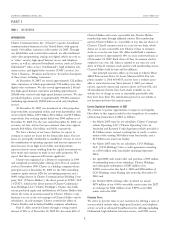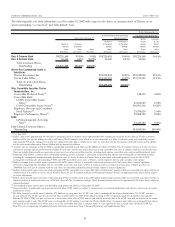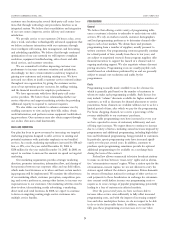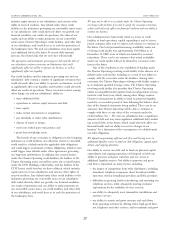Charter 2007 Annual Report Download - page 22
Download and view the complete annual report
Please find page 22 of the 2007 Charter annual report below. You can navigate through the pages in the report by either clicking on the pages listed below, or by using the keyword search tool below to find specific information within the annual report.
cable system. In 2007, major DBS competitors offered a greater
variety of channel packages, and were especially competitive
with promotional pricing for more basic services, such as a
monthly price of approximately $35 for 100 channels compared
to approximately $50 for the closest comparable package offered
by us in most of our markets. In addition, while we continue to
believe that the initial investment by a DBS customer exceeds
that of a cable customer, the initial equipment cost for DBS has
decreased substantially, as the DBS providers have aggressively
marketed offers to new customers of incentives for discounted or
free equipment, installation, and multiple units. DBS providers
are able to offer service nationwide and are able to establish a
national image and branding with standardized offerings, which
together with their ability to avoid franchise fees of up to 5% of
revenues and property tax, leads to greater efficiencies and lower
costs in the lower tiers of service. However, we believe that
cable-delivered OnDemand and Subscription OnDemand services
are superior to DBS service, because cable headends can provide
two-way communication to deliver many titles which customers
can access and control independently, whereas DBS technology
can only make available a much smaller number of titles with
DVR-like customer control. We also believe that our higher tier
services, particularly bundled premium packages, are price-com-
petitive with DBS packages, and that many consumers prefer our
ability to economically bundle video packages with high-speed
Internet packages. Further, we have the potential in some areas
to provide a more complete “whole house” communications
package when combining video, high-speed Internet, and tele-
phone services. We believe that this ability to bundle services
differentiates us from DBS competitors and could enable us to
win back former customers who migrated to satellite. However,
joint marketing arrangements between DBS providers and tele-
communications carriers allow similar bundling of services in
certain areas. DBS providers have also made attempts at wide-
spread deployment of high-speed Internet access services via
satellite, but those services have been technically constrained and
of limited appeal. DBS providers are offering more high defini-
tion programming, including local high definition programming.
Telephone Companies and Utilities
Charter’s telephone service competes directly with established
telephone companies and other carriers, including internet-based
VoIP providers, for voice service customers. Because we offer
voice services, we are subject to considerable competition from
telephone companies and other telecommunications providers.
The telecommunications industry is highly competitive and
includes competitors with greater financial and personnel
resources, strong brand name recognition, and long-standing
relationships with regulatory authorities and customers. More-
over, mergers, joint ventures and alliances among our competi-
tors have resulted in providers capable of offering cable
television, Internet, and telephone services in direct competition
with us. For example, major local exchange carriers have entered
into joint marketing arrangements with DBS providers to offer
bundled packages combining telephone (including wireless),
high-speed Internet, and video services.
DSL service allows Internet access to subscribers at data
transmission speeds greater than those available over conven-
tional telephone lines. DSL service therefore is more competitive
with high-speed Internet access over cable systems than conven-
tional dial-up. Most telephone companies, which already have
plant, an existing customer base, and other operational functions
in place (such as, billing, service personnel, etc.), offer DSL
service. We expect DSL to remain a significant competitor to
our high-speed Internet services, particularly as telephone com-
panies bundle DSL with telephone service. In addition, the
continuing deployment of fiber into telephone companies’ net-
works (primarily by Verizon Communications, Inc. (“Verizon”))
will enable them to provide even higher bandwidth Internet
services.
We believe that pricing for residential and commercial
Internet services on our system is generally comparable to that
for similar DSL services and that some residential customers
prefer our Internet services bundled with our video and/or
telephone services, and prefer our high Internet speeds. However,
DSL providers may currently be in a better position to offer data
services to businesses since their networks tend to be more
complete in commercial areas. They also have the ability to
bundle telephone with Internet services for a higher percentage
of their customers.
Telephone companies, including AT&T Inc. (“AT&T”) and
Verizon, can offer video and other services in competition with
us, and we expect they will increasingly do so in the future.
AT&T and Verizon are both upgrading their networks. Some
upgraded portions of these networks carry two-way video ser-
vices comparable to ours, in the case of Verizon, high-speed data
services that operate at speeds as high as or higher than ours,
and digital voice services that are similar to ours. In addition,
these companies continue to offer their traditional telephone
services, as well as service bundles that include wireless voice
services provided by affiliated companies. Based on internal
estimates, we believe that AT&T and Verizon are offering video
services in areas serving approximately 5% to 6% of our esti-
mated homes passed as of December 31, 2007. Additional
upgrades and product launches, primarily by AT&T, are
expected in markets in which we operate.
In addition to telephone companies obtaining franchises or
alternative authorizations in some areas and seeking them in
others, they have been successful through various means in
weakening or streamlining the franchising requirements applica-
ble to them. They have had significant success at the federal and
state level, securing an FCC ruling and numerous state franchise
laws that facilitate their entry into the video marketplace.
Because telephone companies have been successful in avoiding
or weakening the franchise and other regulatory requirements
that remain applicable to cable operators like us, their competi-
tive posture has often been enhanced. The large scale entry of
major telephone companies as direct competitors in the video
marketplace could adversely affect the profitability and valuation
of our cable systems.
Additionally, we are subject to competition from utilities
that possess fiber optic transmission lines capable of transmitting
CHARTER COMMUNICATIONS, INC. 2007 FORM 10-K
11
























